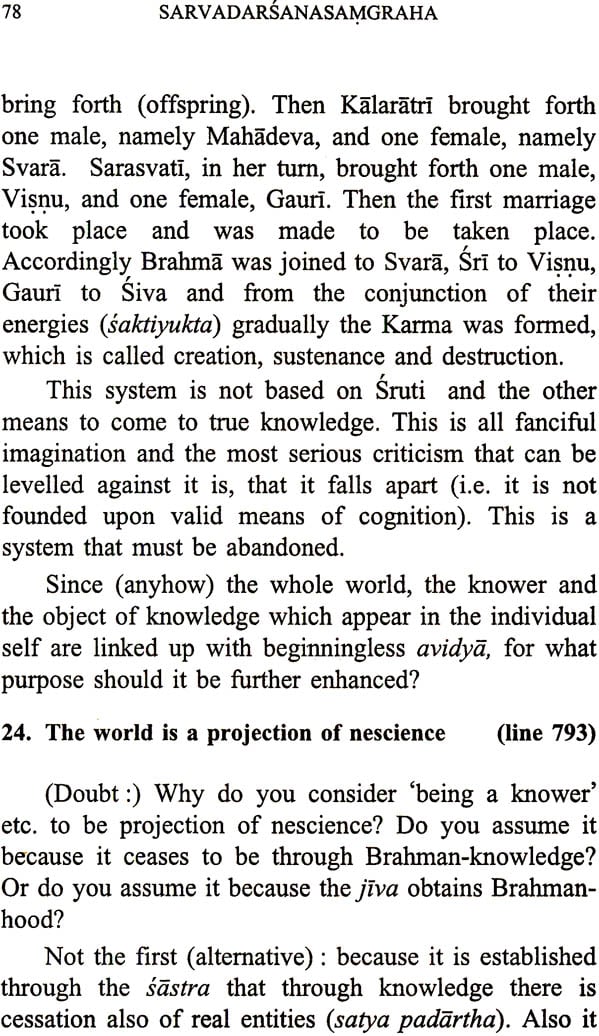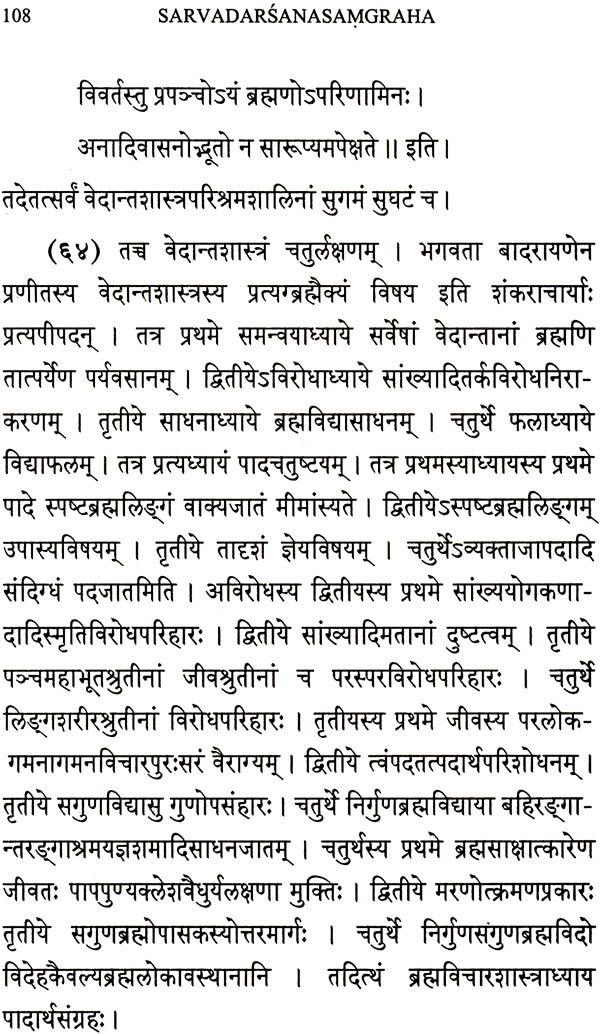
Sarvadarsanasamgraha : Ascribed To Madhavacarya (Chapter 16:Samkaradrsanam)
Book Specification
| Item Code: | NAE454 |
| Author: | Klaus K.Klostermaier |
| Publisher: | The Adyar Library and Research Centre |
| Language: | Sanskrit Text With English Translation |
| Edition: | 1999 |
| ISBN: | 8185141320 |
| Pages: | 156 |
| Cover: | Hardcover |
| Other Details | 8.5 inch X 5.5 inch |
| Weight | 330 gm |
Book Description
Sarvadarsanasamgraha ascribed to Madhavacarya was translated into English by E.B. Cowell and A.E. Gough (published from London, 1892, 1894): The last section dealing with Samkaradarsana which was not included there has now been translated by Klaus K. Klostermaier, and is being published here with the original text. Ananthalal Thakur has shown that the real author was Cennu Bhatta, one of the Pandits in the court of Mädhava.
The Sarvadarsanasamgraha, ascribed to Mdhava, deals with the different systems of philosophy in India, and has been very popular. The last section deals with Samkara’s system. E.B. Cowell and A.E. Gough translated the text (except the last section) into English (London, 1892, 1894). An English translation of the last chapter by Klaus K. Klostermaier is being published here.
In an article published in ALB (vol. 25, 524-38) ‘Canni Bhatta and the authorship of the Sarvadarsanasamgraha’ Professor Ananthalal Thakur has shown that the Sarvadarsanasamgraha, though ascribed to Mdhava, is really the work of Canni Bhatta (Cinna Bhatta or Cennu Bhatta), a younger contemporary of Madhava and Syana and son of Sarvajflavisnu who was also the teacher of Sayana, and Madhava. Cannu Bhatta is the author of Prakãsikã commentary on the Tarkabhãsã of Kesava Mira (BURl, 1937), and the Vivarana commentary on Varadaraj a’s Tärkikaraksa-sarasamgraha. This Canna Bhatta was one of the many Pandits in the court of Madhava, and rose to the position of Rajapandita.
In the Vivarana, at the conclusion of the Anumãna section he says that, ‘positive and negative coexistence indubitably establishes invariable concomitance when corroborative arguments come to their aid’. He adds that this has been established in his own Sarvadar.anasarngraha:
The attribution of Sarvadarsanasamgrahe of Cannu Bhatta to Madhava may be explained on the ground that the work was written under the patronage of Mädhava, and at his instance.
In the introduction to this English Translation Dr. Klostermaier has taken the generally accepted view that Madhavacarya is the author of the work. But now we have definite evidence to show that Cennu Bhatta is the author (see Ananthalal Thakur’s paper in the ALB, vol. 25). The translation is based on the BORI edition of the text, keeping the line numbers to enable the readers to check with the original without difficulty. Professor Thangaswami Sarma who helped the translator in understanding the text was available in the Library for consultation wherever necessary. The English Translation was published in the ALB, 1997. It is reprinted in this volume. The Sanskrit text published as an appendix retains the original number of the BORI edition.
E.B. Cowell and A.E. Gough, in their often reprinted translation of the Sarvadarsanasamgraha (SDS)’ concluded their work after the fifteenth chapter (Pãtañjaladarsanam) with the remark that the author had dealt with the Advaita system in another of his works and had thus left it out from the SDS. Vãsudev Shastri Abhyankar, whose Sanskrit text of the SDS has become the most widely used edition, includes a sixteenth chapter dealing with the Samkaradarsanam.
Doubts as regards the authenticity of Ch. XVI have been expressed. Internal as well as external reasons can be found to accept it as the work of the author of the SDS. I agree with Hajime Nakamura4 that this chapter ‘is closely and consistently linked up with the preceding chapters’ and that ‘the idioms and the style of this chapter are similar to those of the preceding chapters’. There are frequent (implicit) cross-references to former chapters (especially in the polemics against Samkhya and Mimamsa) and it makes use of sources drawn upon before.
Considering the structure of the SDS it makes eminent sense to crown the polemics against all other systems with a statement on Advaita Vednta, from whose vantage point the critique was undertaken, even if systems were eliminated with the arguments of systems other than Advaita. Chap. XVI offers a critique of all the major systems no longer from the standpoint of another (objectionable) system but from the ‘ultimate’ standpoint of the only true system Advaita Vedãnta.
Finally, following a cue in the Mañgalasloka (v. 4), where Madhava describes his work as a garland of variegated flowers, keeping in mind that garlands normally contain multiples of 8, does it not make better sense to have 16 (2 x 8) than 15 chapters ?
The SDS has been commonly ascribed to Madhava, A.D. 1296-1386, the author of the Vivaranaprameya-samgraha, the Jivanmuktiviveka, the PaFIcadai, the commentary on the Parãarasmrti and some other works. The identity of Syana Mãdhava and Vidyaranya Bhãratitirtha has been widely discussed. This is not the place to enter into the ongoing debate about the person and the life work of the author of the SDS. P.V. Kane and R. Thangaswami have ably summarized the literature and have confirmed the traditional position.
The teachings of Madhavacärya have been expounded in a masterful way by T.M.P. Mahadevan.7 The part of the SDS whose translation follows does not substantially add to, or change, this account.
The SDS has attracted the attention of scholars ever since its text was rediscovered: its conciseness and its completeness as well as the method it employed gave it a unique character. Since the early pioneers made their translation of it, much work has been done. Better manuscripts of the SDS were found, individual texts of the many systems dealt with in the SDS were published and translated and several of the chapters of the SDS were freshly translated.
All translators of the SDS have commented on its difficulty. The style is terse and sometimes elliptic. The great number of works referred to or quoted from—frequently exhibiting considerable textual differences vis-a-vis the editions which we possess—and the rapid changes from objection to argument to counter-objection etc. tend to obfuscate the line of thought.
In preparing the present translation I have had the good fortune of expert advice and help. Sri R. Thangaswami, Reader in Sanskrit, University of Madras, went with me through the text while I was on sabbatical leave from the University of Manitoba and was associated as visiting Professor with the S. Radhakrishnan Institute for the Advanced Study of Philosophy at the University of Madras.
Pandit Thangaswami’s mastery of Sanskrit and his intimate knowledge of the Sastra-s made this an educational experience for me. Back home in Manitoba, I had the advantage of being able to revise parts of my translation with the help of Dr. T. R. V. Murti (Benares) and Dr. R. Balasubramaniam (Madras), who, on a visit to some Canadian universities, spent some time here. I have to thank them for many improvements and corrections. I take full responsibility for the shortcomings of this first translation.
V.S. Abhyankar was able, to trace a fairly large number of quotations in the Smkaradarsana chapter. H. Nakamura added quite a few to these. I have been able to track down a few more9 while admitting defeat in about a dozen cases.
In translating this chapter I have found V.S. Abhyankar s Sanskrit commentary to his edition helpful and have also made use of Professor Shankar Sharma’s Hindi paraphrase. The line number in the translation refers to that of the Sanskrit text in BORI edition.
| Preface | v | |
| Introduction | 1 | |
| 1 | Refutation of Samkhya | 5 |
| 1a | No Scriptural Proof For Causality of Prakrit | 6 |
| 1b | Refutation of Samkhya-Illustration | 7 |
| 2 | Subject Matter of The Vedanta Sutra | 11 |
| 3 | Desire To Know Brahman: First Adhikarana | 13 |
| 4 | Desire To Know The Atman Is Impossible - Impossibility Of Doubt | 13 |
| 4a | Impossibility Of Desire, To Know The Self | 16 |
| 5 | Possibility of Beginning Of Brahmajijnasa : Uttarapaksa | 20 |
| 5a | Example For These Six Characteristics | 21 |
| 6 | Superimposition of Self-Examination of The Vaisesika System | 22 |
| 6a | Proof of Superimposition of Atman Refutation of Difference | 24 |
| 6b | Jaina Opinion of Jiva Refuted | 25 |
| 7 | Refutation of Yogacaras - Vijnana Is Atman | 26 |
| 8 | Doubt About The Subject of Atman | 28 |
| 9 | Agama As The Means To Ascertain Brahman | 30 |
| 10 | Purvapaksa : For Obtaining Definite Knowledge The Veda Is Not A Pramana | 31 |
| 10a | Meaning of Words From Established Meaning: Uttarapaksa | 33 |
| 11 | Explanation of Superimposition - Shape of Change of World | 36 |
| 11a | Difference of Superimposition | 36 |
| 12 | Criticism of Superimposition By Mimamsaka - S : Long Purvapaksa | 38 |
| 12a | Absence of Proof For Illusory Knowledge | 39 |
| 12b | There Is No Knowledge of The Content of Non-Being | 41 |
| 12c | Conjuction of Cognition And Remembrance | 41 |
| 12d | Non-Difference Or Identity of Perception And Memory | 43 |
| 12e | The Common Explanation of 'Yellow Conch' | 45 |
| 13 | The Final Proof of 'That Is Not Silver' : The Mimamsaka Opinion | 46 |
| 13a | Critique of Abhava From Prabhakara Standpoint | 47 |
| 14 | The 'Reality' of Illusory Knowledge - Samkara's Answer | 49 |
| 14a | Superimposition of Nacre On Silver | 51 |
| 15 | Assuaging Doubt Concerning Superimposition | 54 |
| 15a | Reply To Mimamsaka Criticism | 55 |
| 16 | Censure of Madhyamika : Erroneous Thought | 58 |
| 16a | Refutation of Vijnanavadin - s : Erroneous Thought | 59 |
| 16b | Refutation of The Anyathakhyati of The Naiyayika - S | 61 |
| 17 | Unity of Cognition of 'This' And 'Silver' : Doubt Resolution | 62 |
| 18 | Threefold Truth/Reality And The Anirvacaniyakhyati | 64 |
| 18a | Sameness of Maya And Avidya | 66 |
| 19 | Proof For The Existence of Avidya | 68 |
| 19a | Refutation of Naiyayika And The Direct Experience of 'I Am Ignorant' | 69 |
| 20 | Establishment of The Nature of Ignorance Through Another Interpretation of 'I Am Ignorant' | 72 |
| 21 | Establishment of Nescience Through Inference (Deduction) | 73 |
| 22 | Avidya Can Be Ascertained From Sruti | 76 |
| 23 | Maya Sakti In Saktism | 77 |
| 24 | The World Is A Projection of Nescience | 78 |
| 25 | Critique of The Reality of The World : There Is No Sublation of Reality | 83 |
| 26 | Cessation of Nescience Through Self Knowledge - The Parable of The Prince | 85 |
| 27 | Conclusion of First Sutra And Connection With Following | 88 |
| 28 | The Other Sutra-s of Catuhsutra; Svarupa And Tatastha Laksana | 88 |
| Bibliography | 91 | |
| Notes | 96 | |
| Appendix : Samkaradarsanam | 105 |







